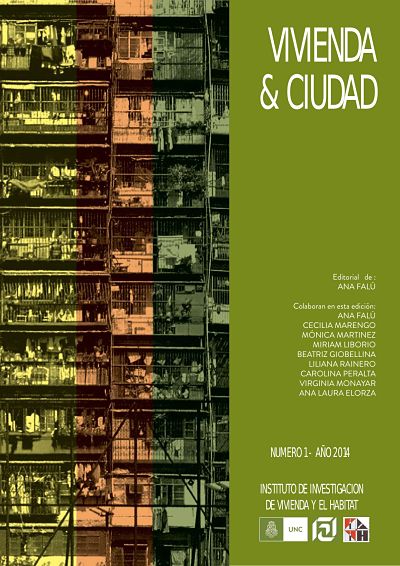El riesgo en la ordenación de Centros urbanos de pequeña escala. Caso de Estudio: Unquillo
Keywords:
Risk, Management, Highland citiesAbstract
This presentation shows a first step of the investigation project of the Secretaría de Ciencia y Técnica of the Universidad Nacional de Córdoba (SeCyT-UNC), “The risk in the management of small scale urban centers. Application in highland and lowland cities in the province of Cordoba”, currently under development. The project addresses the environmental risk that are caused by socio-natural threats from human induced risks in highland and lowland cities in the province of Córdoba and their impact in land use planning, urban development plans and urban and environmental codes. Among the socio-natural threats, the increased frequency of extreme weather events due to global climate change, there has been an increase on the impact of land use and urban planning which, up to now, has been relatively unknown. Likewise, the risk produced by human induced risks has caused a lack of knowledge about how to address this problem in local governments. In this project, we selected a significant risk case of study: the highland city of Unquillo, at the west of the state of Córdoba, which expose dominant socio-natural threats.References
AUDEFROY, J. (2006). Los indicadores de vulnerabilidad y riesgo: una revisión crítica. En
CEVE, I Seminario Iberoamericano de Ciencia y Tecnología para el Hábitat Popular.
Cons- trucción y participación del Conocimiento. Córdoba: CEVE.
AYALA, Carcedo (1993). Estrategias para la reducción de desastres naturales.En:
Investigación y Ciencia n°1 200, p. 6-13
BARBEITO, A. C. (2010). Evaluación hidrogeomorfológica de la amenaza por crecientes
repentinas. Ciudad de Unquillo. Córdoba.
BORTHAGARAY, J. M. (2009). Impacto del cambio climático global sobre el territorio
argentino. Buenos Aires: Nobuko.
Ley Provincial nº 8102. Regimen de Municipios y
comunas. .
LLAVELL, A. (1993). Ciencias sociales y desastres naturales en América Latina: un encuentro
inconcluso. En Maskrey, A. Los desastres no son naturales. Bogotá: La Red.
LLOP, J. M. (2010). Programa UIA CIMES + Cátedra Unesco Ciudades Intermedias. Documento
Guía Plan Base Desarrollo Sostenible en ciudades intermedias. Barcelona:
Universidad Politécnica de Catalunya.
LUNGO, M. (2004). Producción del hábitat popular en condiciones de riesgo. San José
de Costa Rica: Centro Cooperativo Sueco.
MORENO FLORES, O. (2008). “Gestión Ambiental Urbana y desarrollo sustentable.
Consideraciones desde un enfoque social sobre nuestro hábitat urbano.” En: Revista
electrónica ambiente Total 1 (1), 1-8.
PNUD (2004). La reducción de riesgo de desastre: un desafío para el desarrollo. Informe
Mundial. Nueva York:PNUD
RAMOS ÁLVAREZ, M. (2005). Metodología para la evaluación de una política de gestión de
riesgos ante desastres naturales y antrópicos. Caracas: Red XIV-G "Habitat en
Riesgo" del CYTED.
La lluvia dejó daños, evacuados y cortes de luz.Las zonas mas afectadas fueron Río Segundo,
Pilar y Villa General Belgrano. (2006,27 de noviembre). La Voz. Recuperado
de: http://archivo.lavoz.com.ar/herramientas/imprimir_nota.asp?nota_id=22081
Lo que pasó en Unquillo no fué una catástrofe inesperada. (2007, 11 de febrero). Diario
La Voz, pág. 11
Temen por los efectos de la contaminación en el Xanaes. (2008,10 de mayo). Diario La
Voz, pág. 12.
Downloads
Issue
Section
License
Authors who publish in this journal agree to the following terms:
a. Authors retain copyright and guarantee to the journal the right to be the first publication of the work as well as licensed under a Creative Commons Attribution-ShareAlike 4 license.
b. Authors may separately establish additional agreements for non-exclusive distribution of the version of the work published in the journal (e.g., placing it in an institutional repository or publishing it in a book), with an acknowledgement of its initial publication in this journal.
c. Authors are permitted and encouraged to disseminate their work electronically (e.g., in institutional repositories or on their own website) before and during the submission process, as this may result in productive exchanges, as well as earlier and greater citation of published work (See The Effect of Open Access).
d. 4.0 International Creative Commons Attribution-ShareAlike 4.0 License.










